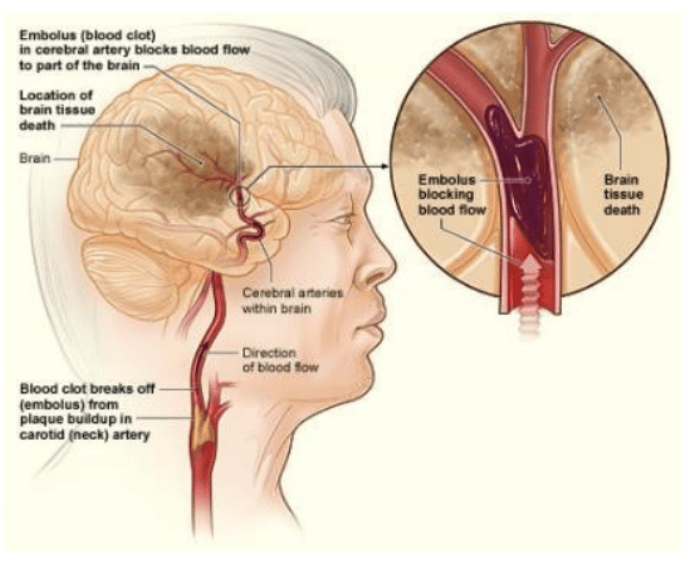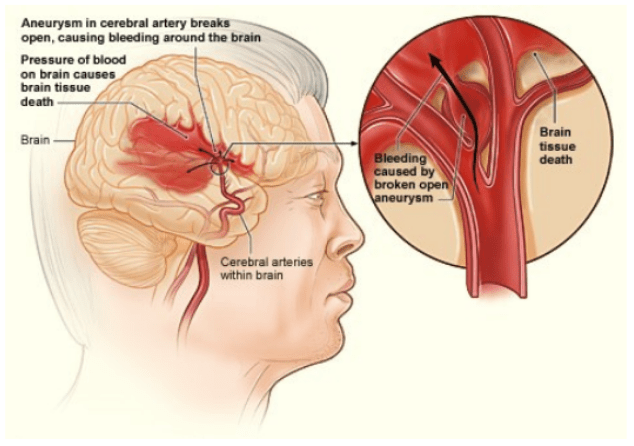About Cardiovascular Disease in Stroke
A Cerebrovascular Accident (CVA) is also known as a Stroke. There are two main types of stroke, Ischaemic and Haemorrhagic stroke.
Ischaemic Stroke:

An ischaemic stroke refers to a stroke that’s usually caused by a plaque deposit (atherosclerotic plaque) or blood clot that obstructs blood flow to the brain and results in damage to the brain tissue.
Haemorrhagic Stroke:

A haemorrhagic stroke is caused by a bleed in the brain which disrupts the flow of blood to a particular region of the brain. This is usually caused by a weakened cerebral artery that can cause swelling and damage to the site if bleeding. Aneurysms and high blood pressure can also lead to this bleed occurring.1
Transient Ischaemic Attacks (TIA)
A transient ischaemic attack is often referred to as a “mini-stroke.” In these cases, patients may present with similar symptoms to a patient who has suffered a traditional “ischaemic stroke” but the symptoms can resolve in 24 hours, in many cases these symptoms often resolve within minutes to hours.
It’s estimated that approximately 30% of patients who have had an ischaemic stroke, may have already had a precipitating transient ischaemic attack.2
What are the causes of Stroke?
The known causes of stroke include but are not limited to:
- Cryptogenic, which refers to no known cause of stroke, but the patient has clinical signs,
- Hypertension,
- Dyslipidaemia,
- Atherosclerosis in large vessels,
- Abdominal obesity,
- Diabetes mellitus,
- Smoking,
- High-fat diets,
- Hypercoagulopathy, which is an increased risk of clot formation, and
- Atrial Fibrillation.3
What are the Signs and Symptoms of a Stroke?
In most cases, the signs of a stroke will present in patients as a neurological deficit related to the area of the brain that has been affected by the stroke. Patients with a clinical suspicion of stroke may present with:
- Speech deficit (slurred or inability to form words),
- Memory deficit,
- Limb paralysis or loss of power,
- Vision disturbances,
- Incontinence,
- Confusion,
- Unstable when walking,
- Altered level of consciousness or drowsy,
- Facial weakness or drooping,
- Poor limb coordination, or
- Difficulty swallowing.4
How to recognise the signs and symptoms of a Stroke
How to diagnose a stroke
The diagnosis of stroke usually occurs when a patient presents with symptoms as outlined above and a Physician has a high suspicion of stroke. The definitive diagnosis of stroke is usually confirmed on either a CT scan or in some cases an MRI scan.5
What is the treatment of Stroke?
The immediate treatment for a stroke will depend upon the type of stroke, that being an Ischaemic or Haemorrhagic stroke.
Ischaemic Stroke:
An ischaemic stroke is often treated using a combination of medications to treat the causes. There are two main treatment options:
- Thrombolysis refers to medications that dissolve a clot that may cause the obstruction in blood flow to the brain, resulting in the patient symptoms. This medication can be administered in the first few hours after symptoms present. Presenting in Hospital with these symptoms may improve patient outcomes.
- Clot Retrieval is a procedure where a catheter is placed within the arterial blood supply (similar to a Coronary Angiogram) and a doctor attempts to locate, find and remove the clot that is causing the obstructed blood flow by using a series of small wires and other tools that help to remove the clot from the cerebral circulation.
- Medications that control and lower high blood pressure may be administered, as well as, medications that reduce the ability of platelets to stick together may be administered after a stroke.
Haemorrhagic Stroke:
Hemorrhagic stroke is caused by a bleed into the brain, resulting in symptoms of weakness and trouble with speech. The treatment for this type of stroke may include:
- Medications to lower blood pressure.
- Surgery to stop bleeding or to evacuate the area where bleeding has occurred. This may include a ruptured aneurysm (arterial wall weakness) where a small clip may be placed around the damaged vessel. In some occasions a small coil may be introduced into the area and this will attempt to prevent further bleeding.
- If the patient is taking anticoagulants, treatment may be based on reversing these medications, if appropriate.6
What is a stroke?
Rehabilitation after Stroke
Once the patients’ condition has become stable after initial treatment, rehabilitation can begin. This may take place in the hospital or at home if the patient is well enough to be discharged. Recovery from stroke will depend on the size of the injury, the area injured and previous medical conditions that may have been present prior to the stroke. Rehabilitation is a specialised process that involves highly trained experts with particular skills related to patients who has suffered a stroke.
Rehabilitation will include a multidisciplinary team who will all provide specialist attention to assist in recovery. In many cases these teams include:
- Physiotherapist,
- Speech therapist,
- Occupational therapist,
- Psychologists,
- Neuropsychologist, and
- Geriatrician or Rehabilitation Physician.7
